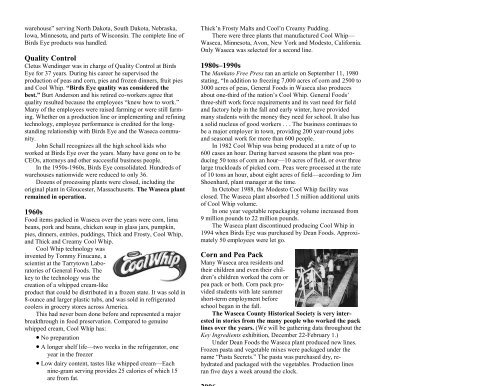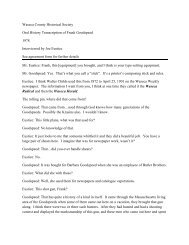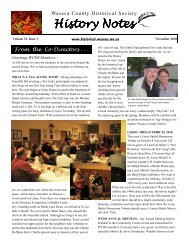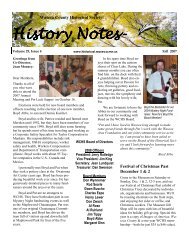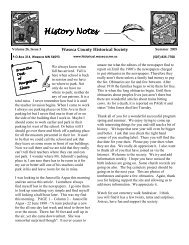Fall - Waseca County Historical Society
Fall - Waseca County Historical Society
Fall - Waseca County Historical Society
Create successful ePaper yourself
Turn your PDF publications into a flip-book with our unique Google optimized e-Paper software.
warehouse” serving North Dakota, South Dakota, Nebraska,<br />
Iowa, Minnesota, and parts of Wisconsin. The complete line of<br />
Birds Eye products was handled.<br />
Quality Control<br />
Cletus Wendinger was in charge of Quality Control at Birds<br />
Eye for 37 years. During his career he supervised the<br />
production of peas and corn, pies and frozen dinners, fruit pies<br />
and Cool Whip. “Birds Eye quality was considered the<br />
best.” Burt Anderson and his retired co-workers agree that<br />
quality resulted because the employees “knew how to work.”<br />
Many of the employees were raised farming or were still farming.<br />
Whether on a production line or implementing and refining<br />
technology, employee performance is credited for the longstanding<br />
relationship with Birds Eye and the <strong>Waseca</strong> community.<br />
John Schall recognizes all the high school kids who<br />
worked at Birds Eye over the years. Many have gone on to be<br />
CEOs, attorneys and other successful business people.<br />
In the 1950s-1960s, Birds Eye consolidated. Hundreds of<br />
warehouses nationwide were reduced to only 36.<br />
Dozens of processing plants were closed, including the<br />
original plant in Gloucester, Massachusetts. The <strong>Waseca</strong> plant<br />
remained in operation.<br />
1960s<br />
Food items packed in <strong>Waseca</strong> over the years were corn, lima<br />
beans, pork and beans, chicken soup in glass jars, pumpkin,<br />
pies, dinners, entrées, puddings, Thick and Frosty, Cool Whip,<br />
and Thick and Creamy Cool Whip.<br />
Cool Whip technology was<br />
invented by Tommy Finucane, a<br />
scientist at the Tarrytown Laboratories<br />
of General Foods. The<br />
key to the technology was the<br />
creation of a whipped cream-like<br />
product that could be distributed in a frozen state. It was sold in<br />
8-ounce and larger plastic tubs, and was sold in refrigerated<br />
coolers in grocery stores across America.<br />
This had never been done before and represented a major<br />
breakthrough in food preservation. Compared to genuine<br />
whipped cream, Cool Whip has:<br />
• No preparation<br />
• A longer shelf life—two weeks in the refrigerator, one<br />
year in the freezer<br />
• Low dairy content, tastes like whipped cream—Each<br />
nine-gram serving provides 25 calories of which 15<br />
are from fat.<br />
Thick’n Frosty Malts and Cool’n Creamy Pudding.<br />
There were three plants that manufactured Cool Whip—<br />
<strong>Waseca</strong>, Minnesota, Avon, New York and Modesto, California.<br />
Only <strong>Waseca</strong> was selected for a second line.<br />
1980s–1990s<br />
The Mankato Free Press ran an article on September 11, 1980<br />
stating, “In addition to freezing 7,000 acres of corn and 2500 to<br />
3000 acres of peas, General Foods in <strong>Waseca</strong> also produces<br />
about one-third of the nation’s Cool Whip. General Foods’<br />
three-shift work force requirements and its vast need for field<br />
and factory help in the fall and early winter, have provided<br />
many students with the money they need for school. It also has<br />
a solid nucleus of good workers . . . The business continues to<br />
be a major employer in town, providing 200 year-round jobs<br />
and seasonal work for more than 600 people.<br />
In 1982 Cool Whip was being produced at a rate of up to<br />
600 cases an hour. During harvest seasons the plant was producing<br />
50 tons of corn an hour—10 acres of field, or over three<br />
large truckloads of picked corn. Peas were processed at the rate<br />
of 10 tons an hour, about eight acres of field—according to Jim<br />
Shoenhard, plant manager at the time.<br />
In October 1988, the Modesto Cool Whip facility was<br />
closed. The <strong>Waseca</strong> plant absorbed 1.5 million additional units<br />
of Cool Whip volume.<br />
In one year vegetable repackaging volume increased from<br />
9 million pounds to 22 million pounds.<br />
The <strong>Waseca</strong> plant discontinued producing Cool Whip in<br />
1994 when Birds Eye was purchased by Dean Foods. Approximately<br />
50 employees were let go.<br />
Corn and Pea Pack<br />
Many <strong>Waseca</strong> area residents and<br />
their children and even their children’s<br />
children worked the corn or<br />
pea pack or both. Corn pack provided<br />
students with late summer<br />
short-term employment before<br />
school began in the fall.<br />
The <strong>Waseca</strong> <strong>County</strong> <strong>Historical</strong> <strong>Society</strong> is very interested<br />
in stories from the many people who worked the pack<br />
lines over the years. (We will be gathering data throughout the<br />
Key Ingredients exhibition, December 22-February 1.)<br />
Under Dean Foods the <strong>Waseca</strong> plant produced new lines.<br />
Frozen pasta and vegetable mixes were packaged under the<br />
name “Pasta Secrets.” The pasta was purchased dry, rehydrated<br />
and packaged with the vegetables. Production lines<br />
ran five days a week around the clock.


